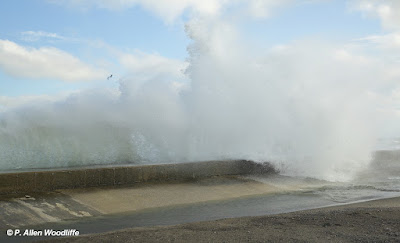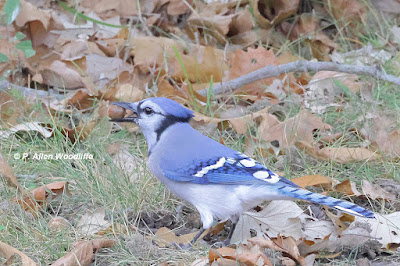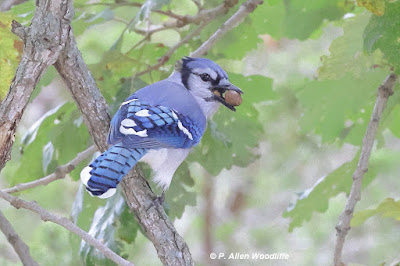October can be one of the windiest months of the year. When strong east type winds occur, I like to get out to Erieau and watch the power of the waves hitting the pier.
It can be impressive, to say the least. One must be careful with the camera to protect it from wind-blown sand and spray. The first two photos were not taken this October, but on another occasion when the conditions were just right for these photos. Maybe later this month, or when the gales of November arrive, I will be photographing there again.I did get out to the southern part of Rondeau a couple of days ago, and the wind direction was from the south, and brisk. This next photo shows the wildest ones I was able to get. Nice, but nothing like a strong east wind at Erieau.
Rondeau is the place to be almost anytime of the year, but I particularly like it in the autumn. The changes happen steadily. It was only a couple of weeks ago when most of the forest looked like this next photo.
Just a couple of days ago, the changes were quite obvious, as shown next, but in the next week or two, the colours will be much more dramatic.Birds have been steadily arriving, and departing, as they should. Blue Jays have been passing through in large numbers, and making good use of the abundant crop of acorns on many oak species this year.
Yellow-rumped Warblers are by far the most common warbler species now, and with a good crop of berries on things like Red Cedar, have lots to keep them happy while they build up reserves for the next leg of their southward journey.
White-throated Sparrows are increasing in abundance......
...as are Rusty Blackbirds. It is a species at risk overall, but can be reasonably common for a short time in the autumn.
One of the most common members of the thrush family is the Hermit Thrush, next.
There are some lingering species, such as this Eastern Phoebe, a flycatcher that has to deviate from flying insects once the cold weather arrives. However with the impressive hatch of midges in the last week or so, there is lots of food for flycatchers in the short term.
Lots of the summer sparrow residents have gone, to be replaced by the autumn/winter species, but sometimes some of the summer ones linger, such as this Chipping Sparrow. Of course the weather conditions haven't been all that bad yet, so there will be a few species and individuals reluctant to move any farther south than necessary.
Robins, with their diverse diet, will stick around for quite awhile yet, even well into or over the winter.
I had intended to stop at the Keith McLean Conservation Lands to look for, and hopefully photograph, one of the Nelson's Sparrows that is currently there. However since I neglected to return the flash card to the camera after having downloaded the images from the day before, my camera was not functional! Oh well, live and learn (I hope!). Maybe this coming week I will have my act together better, and it will coincide with a cooperative Nelson's Sparrow or two. One can always hope, since this species can be quite elusive even at the best of times.
I've been to St. Clair NWA and the Mitchell's Bay lakeshore trails a time or two recently, partly because they are closer to home than Rondeau. With much of the habitat in these areas being wetland, it is not surprising that quite a few Swamp Sparrows can be found.
Rusty Blackbirds, a species that prefers wet woodlands and similar habitat types, will be around.
Sandhill Cranes continue to be in the area. Their yodeling calls can be heard from quite a distance, enabling a photographer to get ready if they come close enough.
On one occasion I saw at least a dozen in the area in about an hour's time in the late afternoon. Overcast skies do make it a bit more challenging to photograph.
A few Great Egrets continue to be seen. Their numbers are diminishing but as long as there is open water, a few may continue to be in the area. I have even seen up to three in early January in the past!
The Lake St. Clair Marshes are well known for attracting waterfowl, and therefore hunters. In fact it was in part due to hunt clubs of the past to protect some of these wetlands over the years, and we are enjoying the benefits of those efforts nowadays, even while some private wetlands continue to be used by hunters from both sides of the border. Due to no hunting at St. Clair NWA, it is a great place to observe the huge numbers of ducks and geese making use of this protected wetland. On one occasion recently, I saw anywhere from a few dozen to a thousand or more birds in the air all at once, and it was like that continuously for most of the hour and a half I was walking the dyke trail.
I will be out again, to be sure!
If you would like to subscribe, or unsubscribe, to Nature Nuggets, send an email to: prairietramper@gmail.com
























No comments:
Post a Comment